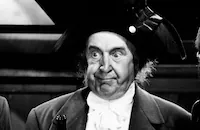Three Live Ghosts

Brief Synopsis
Cast & Crew
H. Bruce Humberstone
Richard Arlen
Beryl Mercer
Claude Allister
Charles Mcnaughton
Cecilia Parker
Film Details
Technical Specs

Synopsis
Just after the end of World War I, American detective Bolton searches London for William Foster, an American who entered the British army under the name "Bill Jones" and was reported killed in action. Bolton goes to see Mrs. Gubbins, the stepmother of Bill's army pal Jimmie, to see if Bill is really dead, but Mrs. Gubbins says that as her son Jimmie is dead, and the two were so close, Bill must be dead, too. Bolton leaves Mrs. Gubbins with a newspaper clipping offering a $1,000 reward for information on Bill and tells her to contact him if she learns anything. Unknown to everyone, Bill and Jimmie and their shellshocked, child-like pal "Spoofy" were prisoners of war and did not know of their reported deaths. When they arrive back in London and go to Mrs. Gubbins' flat, she is delighted to see them, but worried that she will be put in jail for spending the government life insurance money given to her after Jimmie's presumed death. Ann Gordon, who loves Bill, is happy when she learns that he is alive, but Bill, thinking that he has too many problems to inflict on Ann, pretends that he no longer loves her. When Jimmie and Bill find the news clipping, Bill tells Mrs. Gubbins that she can have half the reward if she gives the other half to Ann. Mrs. Gubbins is willing, but unfortunately cannot remember Bolton's name. When Spoofy overhears Bill's troubles, he secretly goes to a mansion, breaks in, dresses in a morning suit that fits him perfectly, then takes a baby named Tommy from his nursery and returns to Mrs. Gubbins's flat. Mrs. Gubbins is delighted to take care of an amiable baby like Tommy, but when Jimmie and Bill find out that Spoofy has apparently kidnapped the child and taken considerable jewelry as well, they are very worried. Soon the police arrive looking for Bill, but Jimmie says that he has already gone. The police then notice the jewels that Spoofy has given Mrs. Gubbins to wear and demand that she return them. When they see the baby, they are about to arrest Mrs. Gubbins, Jimmie and Spoofy when Bill arrives and says he is responsible. In the confusion, Spoofy leaves, taking little Tommy with him, after which Mrs. Gubbins, Jimmie and Bill are taken to Scotland Yard to be interrogated by Inspector Briggs. Briggs is befuddled by all of the seemingly ridiculous answers the three have to his questions. He then summons Bolton, whose name Mrs. Gubbins finally remembers, and they learn that Bolton does not want Bill for a crime. He then reveals that Bill's father has died, leaving his son a considerable estate, and that Bill can now easily make good on losses that his company had before the war. Just then, a policeman brings in a dazed Spoofy. A blow to Spoofy's head initially made him incoherent, but gradually he remembers everything that has happened to him: During the war, he received a severe blow to the head and could not remember his past when the Germans took him prisoner. Now he remembers that he is actually Lord Brockton, that the house he "robbed" was his own, and baby Tommy is his son. Finally, at the Brockton house, Spoofy and his wife happily entertain Bill and Ann, Mrs. Gubbins and Jimmie.

Director

H. Bruce Humberstone
Cast

Richard Arlen
Beryl Mercer
Claude Allister
Charles Mcnaughton

Cecilia Parker

Dudley Digges
Nydia Westman

Jonathan Hale
Lillian Cooper
Robert Greig
Forrester Harvey
Wallis Clark
Anita Deniston
Fredrik Vogeding
Egon Brecher
Roland Varno
Joe North
Clare Verdera
Sidney Bracy
Crew
Dr. William Axt
John W. Considine Jr.
Cedric Gibbons
Tom Held
James Wong Howe
Chester Lyons
Max Marcin
Gabriel Scognamillo
Douglas Shearer
Al Shenberg
C. Gardner Sullivan
Dolly Tree
Edwin B. Willis

Film Details
Technical Specs

Quotes
Trivia
Notes
Frederic Stewart Isham's play, which was produced by Max Marcin on Broadway, was based on Isham's 1918 novel of the same name. Some sources say that the film was based on the novel, or novel and play, but the film only credits the play. Production charts in Hollywood Reporter incorrectly attribute the play to Marcin and actor Charles McNaughton who, along with Beryl Mercer, had appeared in the Broadway play. According to news items in Hollywood Reporter, Robert Taylor had been set for the lead in the film but was replaced by Richard Arlen shortly before production began. News items in Hollywood Reporter and Daily Variety also note that although shooting commenced on November 6, 1935, the production was halted on 8 Nov. At that time, M-G-M decided to scrap what had been filmed and resume shooting on 14 November with a revised script. The new script changed the setting from a contemporary one to World War I, and led to several cast changes. Cast members who were replaced include Ann Loring, who was initially the romantic lead opposite Arlen, Una O'Connor, Charles Butterworth, May Robson and David Thursby. Three Live Ghosts was previously adapted for the screen under the same title in 1922 and 1929. The 1922 silent Famous Players-Lasky version was directed by George Fitzmaurice and starred Anna Q. Nilsson and Norman Kerry. The 1929 Joseph M. Schenck sound production was produced and adapted by Marcin and directed by Thornton Freeland. That version starred Mercer, McNaughton and Claude Allister, along with Joan Bennett and Robert Montgomery (see AFI Catalog of Feature Films, 1921-30; F2. 5661 and F2.5662).













